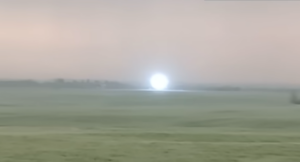Two weeks ago, the dark coast of Wales started lighting up in an ethereal display. Bioluminescence, in the form of swathes of glowing plankton, appeared off the beaches.
Historically known as “the burning of the sea”, it usually occurs in warmer countries like the Maldives and Puerto Rico but can even show up in the Arctic. Bioluminescence in the UK has always been unpredictable but has become more frequent in recent years.

Phytoplankton at Penmon Beach. Photo: Kris Williams
Scientists from local universities suggest that the recent sightings at Caswell Bay, Penmon, and other Welsh beaches owe to particularly stable weather. The alien-like blue glow comes from phytoplankton, whose scientific name is the rather pretty noctiluca scintillans. These photosynthesizing micro-algae bloom exponentially in warm weather and calm seas. High turbidity and low light prevent them from reproducing.

Bioluminescence at Aberavon Beach, Wales. Photo: Emma-Louise Williams/BBC
The blue glow occurs when the water is disturbed and the phytoplankton emits a chemical called luciferin. It is a defense mechanism against predators. It is fairly common in the wake of a ship at night and occasionally even in a small boat’s toilet bowl if it draws its water from the sea.
Near beaches, it tends to occur in sheltered and shallow areas of low turbidity and a greater concentration of nutrients needed for bloom. Despite its beauty, phytoplankton also releases great amounts of ammonia that can threaten surrounding marine life.
Bioluminescence may indicate the sea’s health or lack of it. The phytoplankton thrives in high nitrogen and phosphorous areas. High toxic runoff from pesticides and chemicals from farmlands stimulate the organisms.
Photographers and members of a bioluminescent plankton watching group on Facebook has over 6,000 people. They go out at dusk (where it is most active), and at all hours of the night and early morning to capture the sight on camera.






